Case Study: Genetic and In Silico Analysis of Familial Pancreatitis
Abstract
1. Introduction
2. Materials and Methods
2.1. Human Subjects Determination and Release of Medical Testing Data
2.2. DNA Isolation and Sequencing
2.3. Identification of SNVs and Sequences for Further Study
2.4. GTEX Gene Expression Analysis
2.5. Phylogenetic Alignment Analysis
2.6. Tertiary Protein Structure and Ligand Binding Prediction
2.7. Protein Stability Prediction
3. Results
3.1. Medical Genetic Testing Results
3.2. Pedigree and Analysis of Genomic Locations of Variants
3.3. Sequence Analysis of the Proband and Son
3.4. Allele Frequencies for Tested Variants
3.5. Phylogenetic Analysis of Missense Variants
3.6. Tertiary Structure of Proteins with Ligand Binding Analysis
3.6.1. CFTR Reference Protein and rs213950 Val470Met Variant
3.6.2. CTRC Reference and rs213950 Variant
4. Discussion
5. Conclusions
Supplementary Materials
Author Contributions
Funding
Institutional Review Board Statement
Informed Consent Statement
Data Availability Statement
Acknowledgments
Conflicts of Interest
References
- Beyer, G.; Habtezion, A.; Werner, J.; Lerch, M.M.; Mayerle, J. Chronic pancreatitis. Lancet 2020, 396, 499–512. [Google Scholar] [CrossRef] [PubMed]
- Singh, V.K.; Yadav, D.; Garg, P.K. Diagnosis and Management of Chronic Pancreatitis: A Review. JAMA 2019, 322, 2422–2434. [Google Scholar] [CrossRef]
- Ramsey, M.L.; Heald, B.; Gokun, Y.; Baker, J.; Groce, J.R.; Han, S.; Hart, P.A.; Krishna, S.G.; Lara, L.F.; Lee, P.J.; et al. Germline multigene panel testing in acute and chronic pancreatitis. PLoS ONE 2024, 19, e0307076. [Google Scholar] [CrossRef]
- Amberger, J.S.; Bocchini, C.A.; Schiettecatte, F.; Scott, A.F.; Hamosh, A. OMIM.org: Online Mendelian Inheritance in Man (OMIM®), an online catalog of human genes and genetic disorders. Nucleic Acids Res. 2015, 43, D789–D798. [Google Scholar] [CrossRef] [PubMed]
- Hamosh, A.; Amberger, J.S.; Bocchini, C.; Scott, A.F.; Rasmussen, S.A. Online Mendelian Inheritance in Man (OMIM®): Victor McKusick’s magnum opus. Am. J. Med. Genet. Part A. 2021, 185, 3259–3265. [Google Scholar] [CrossRef]
- Consortium, G.T. The Genotype-Tissue Expression (GTEx) project. Nat. Genet. 2013, 45, 580–585. [Google Scholar] [CrossRef]
- Rausch, T.; Fritz, M.H.; Untergasser, A.; Benes, V. Tracy: Basecalling, alignment, assembly and deconvolution of sanger chromatogram trace files. BMC Genom. 2020, 21, 230. [Google Scholar] [CrossRef]
- Kitts, A.; Phan, L.; Ward, M.; Holmes, J.B. The Database of Short Genetic Variation (dbSNP); National Center for Biotechnology Information: Bethesda, MA, USA, 2013. Available online: https://www.ncbi.nlm.nih.gov/books/NBK174586/ (accessed on 20 April 2025).
- Goldfarb, T.; Kodali, V.K.; Pujar, S.; Brover, V.; Robbertse, B.; Farrell, C.M.; Oh, D.H.; Astashyn, A.; Ermolaeva, O.; Haddad, D.; et al. NCBI RefSeq: Reference sequence standards through 25 years of curation and annotation. Nucleic Acids Res. 2025, 53, D243–D257. [Google Scholar] [CrossRef]
- Madeira, F.; Pearce, M.; Tivey, A.R.N.; Basutkar, P.; Lee, J.; Edbali, O.; Madhusoodanan, N.; Kolesnikov, A.; Lopez, R. Search and sequence analysis tools services from EMBL-EBI in 2022. Nucleic Acids Res. 2022, 50, W276–W279. [Google Scholar] [CrossRef]
- McGuffin, L.J.; Adiyaman, R.; Maghrabi, A.H.A.; Shuid, A.N.; Brackenridge, D.A.; Nealon, J.O.; Philomina, L.S. IntFOLD: An integrated web resource for high performance protein structure and function prediction. Nucleic Acids Res. 2019, 47, W408–W413. [Google Scholar] [CrossRef]
- Roche, D.B.; Tetchner, S.J.; McGuffin, L.J. FunFOLD: An improved automated method for the prediction of ligand binding residues using 3D models of proteins. BMC Bioinform. 2011, 12, 160. [Google Scholar] [CrossRef] [PubMed]
- Roche, D.B.; Buenavista, M.T.; McGuffin, L.J. The FunFOLD2 server for the prediction of protein-ligand interactions. Nucleic Acids Res. 2013, 41, W303–W307. [Google Scholar] [CrossRef] [PubMed]
- Sehnal, D.; Bittrich, S.; Deshpande, M.; Svobodova, R.; Berka, K.; Bazgier, V.; Velankar, S.; Burley, S.K.; Koca, J.; Rose, A.S. Mol* Viewer: Modern web app for 3D visualization and analysis of large biomolecular structures. Nucleic Acids Res. 2021, 49, W431–W437. [Google Scholar] [CrossRef]
- Capriotti, E.; Fariselli, P.; Casadio, R. I-Mutant2.0: Predicting stability changes upon mutation from the protein sequence or structure. Nucleic Acids Res. 2005, 33, W306–W310. [Google Scholar] [CrossRef]
- Cheng, J.; Randall, A.; Baldi, P. Prediction of protein stability changes for single-site mutations using support vector machines. Proteins 2006, 62, 1125–1132. [Google Scholar] [CrossRef]
- Sayers, E.W.; Beck, J.; Bolton, E.E.; Brister, J.R.; Chan, J.; Comeau, D.C.; Connor, R.; DiCuccio, M.; Farrell, C.M.; Feldgarden, M.; et al. Database resources of the National Center for Biotechnology Information. Nucleic Acids Res. 2024, 52, D33–D43. [Google Scholar] [CrossRef]
- Kopanos, C.; Tsiolkas, V.; Kouris, A.; Chapple, C.E.; Albarca Aguilera, M.; Meyer, R.; Massouras, A. VarSome: The human genomic variant search engine. Bioinformatics 2019, 35, 1978–1980. [Google Scholar] [CrossRef]
- Zhou, D.; Bai, R.; Wang, L. The Cystic Fibrosis Transmembrane Conductance Regulator 470 Met Allele Is Associated with an Increased Risk of Chronic Pancreatitis in Both Asian and Caucasian Populations: A Meta-Analysis. Genet. Test. Mol. Biomark. 2020, 24, 24–32. [Google Scholar] [CrossRef]
- Masson, E.; Chen, J.M.; Scotet, V.; Le Marechal, C.; Ferec, C. Association of rare chymotrypsinogen C (CTRC) gene variations in patients with idiopathic chronic pancreatitis. Hum. Genet. 2008, 123, 83–91. [Google Scholar] [CrossRef]
- Saayman, S.M.; Ackley, A.; Burdach, J.; Clemson, M.; Gruenert, D.C.; Tachikawa, K.; Chivukula, P.; Weinberg, M.S.; Morris, K.V. Long Non-coding RNA BGas Regulates the Cystic Fibrosis Transmembrane Conductance Regulator. Mol. Ther. 2016, 24, 1351–1357. [Google Scholar] [CrossRef]
- Sherry, S.T.; Ward, M.H.; Kholodov, M.; Baker, J.; Phan, L.; Smigielski, E.M.; Sirotkin, K. dbSNP: The NCBI database of genetic variation. Nucleic Acids Res. 2001, 29, 308–311. [Google Scholar] [CrossRef] [PubMed]
- Finkelberg, D.L.; Sahani, D.; Deshpande, V.; Brugge, W.R. Autoimmune pancreatitis. N. Engl. J. Med. 2006, 355, 2670–2676. [Google Scholar] [CrossRef] [PubMed]
- Ludvigsson, J.F.; Montgomery, S.M.; Ekbom, A. Risk of pancreatitis in 14,000 individuals with celiac disease. Clin. Gastroenterol. Hepatol. 2007, 5, 1347–1353. [Google Scholar] [CrossRef]
- Waterhouse, A.; Bertoni, M.; Bienert, S.; Studer, G.; Tauriello, G.; Gumienny, R.; Heer, F.T.; de Beer, T.A.P.; Rempfer, C.; Bordoli, L.; et al. SWISS-MODEL: Homology modelling of protein structures and complexes. Nucleic Acids Res. 2018, 46, W296–W303. [Google Scholar] [CrossRef]
- Wan, Y.; Hudson, R.; Smith, J.; Forman-Kay, J.D.; Ditlev, J.A. Protein interactions, calcium, phosphorylation, and cholesterol modulate CFTR cluster formation on membranes. Proc. Natl. Acad. Sci. USA 2025, 122, e2424470122. [Google Scholar] [CrossRef]
- Chin, S.; Ramjeesingh, M.; Hung, M.; Ereno-Oreba, J.; Cui, H.; Laselva, O.; Julien, J.P.; Bear, C.E. Cholesterol Interaction Directly Enhances Intrinsic Activity of the Cystic Fibrosis Transmembrane Conductance Regulator (CFTR). Cells 2019, 8, 804. [Google Scholar] [CrossRef]
- White, N.M.; Jiang, D.; Burgess, J.D.; Bederman, I.R.; Previs, S.F.; Kelley, T.J. Altered cholesterol homeostasis in cultured and in vivo models of cystic fibrosis. Am. J. Physiol. Lung. Cell. Mol. Physiol. 2007, 292, L476–L486. [Google Scholar] [CrossRef]
- Osborne, J.; Lunasin, A.; Steiner, R.F. The binding of calcium by chymotrypsinogen A. Biochem. Biophys. Res. Commun. 1972, 49, 923–929. [Google Scholar] [CrossRef]
- Sharer, N.; Schwarz, M.; Malone, G.; Howarth, A.; Painter, J.; Super, M.; Braganza, J. Mutations of the cystic fibrosis gene in patients with chronic pancreatitis. N. Engl. J. Med. 1998, 339, 645–652. [Google Scholar] [CrossRef]
- Moon, S.H.; Kim, J.; Kim, M.Y.; Park, D.H.; Song, T.J.; Kim, S.A.; Lee, S.S.; Seo, D.W.; Lee, S.K.; Kim, M.H. Sensitization to and Challenge with Gliadin Induce Pancreatitis and Extrapancreatic Inflammation in HLA-DQ8 Mice: An Animal Model of Type 1 Autoimmune Pancreatitis. Gut Liver 2016, 10, 842–850. [Google Scholar] [CrossRef]
- Gasparini, P.; Borgo, G.; Mastella, G.; Bonizzato, A.; Dognini, M.; Pignatti, P.F. Nine cystic fibrosis patients homozygous for the CFTR nonsense mutation R1162X have mild or moderate lung disease. J. Med. Genet. 1992, 29, 558–562. [Google Scholar] [CrossRef][Green Version]
- Gasparini, P.; Nunes, V.; Savoia, A.; Dognini, M.; Morral, N.; Gaona, A.; Bonizzato, A.; Chillon, M.; Sangiuolo, F.; Novelli, G.; et al. The search for south European cystic fibrosis mutations: Identification of two new mutations, four variants, and intronic sequences. Genomics 1991, 10, 193–200. [Google Scholar] [CrossRef]
- Loo, T.W.; Clarke, D.M. Correction of defective protein kinesis of human P-glycoprotein mutants by substrates and modulators. J. Biol. Chem. 1997, 272, 709–712. [Google Scholar] [CrossRef] [PubMed]
- Wang, Y.; Loo, T.W.; Bartlett, M.C.; Clarke, D.M. Additive effect of multiple pharmacological chaperones on maturation of CFTR processing mutants. Biochem. J. 2007, 406, 257–263. [Google Scholar] [CrossRef] [PubMed]
- Rosendahl, J.; Witt, H.; Szmola, R.; Bhatia, E.; Ozsvari, B.; Landt, O.; Schulz, H.U.; Gress, T.M.; Pfutzer, R.; Lohr, M.; et al. Chymotrypsin C (CTRC) variants that diminish activity or secretion are associated with chronic pancreatitis. Nat. Genet. 2008, 40, 78–82. [Google Scholar] [CrossRef]
- Guignard, S.; Saifeddine, M.; Mihara, K.; Motahhary, M.; Savignac, M.; Guiraud, L.; Sagnat, D.; Sebbag, M.; Khou, S.; Rolland, C.; et al. Chymotrypsin activity signals to intestinal epithelium by protease-activated receptor-dependent mechanisms. Br. J. Pharmacol. 2024, 181, 2725–2749. [Google Scholar] [CrossRef]
- Beer, S.; Zhou, J.; Szabo, A.; Keiles, S.; Chandak, G.R.; Witt, H.; Sahin-Toth, M. Comprehensive functional analysis of chymotrypsin C (CTRC) variants reveals distinct loss-of-function mechanisms associated with pancreatitis risk. Gut 2013, 62, 1616–1624. [Google Scholar] [CrossRef]
- Liu, J.; Berg, A.P.; Wang, Y.; Jantarajit, W.; Sutcliffe, K.J.; Stevens, E.B.; Cao, L.; Pregel, M.J.; Sheppard, D.N. A small molecule CFTR potentiator restores ATP-dependent channel gating to the cystic fibrosis mutant G551D-CFTR. Br. J. Pharmacol. 2022, 179, 1319–1337. [Google Scholar] [CrossRef]
- Jih, K.Y.; Lin, W.Y.; Sohma, Y.; Hwang, T.C. CFTR potentiators: From bench to bedside. Curr. Opin. Pharmacol. 2017, 34, 98–104. [Google Scholar] [CrossRef]
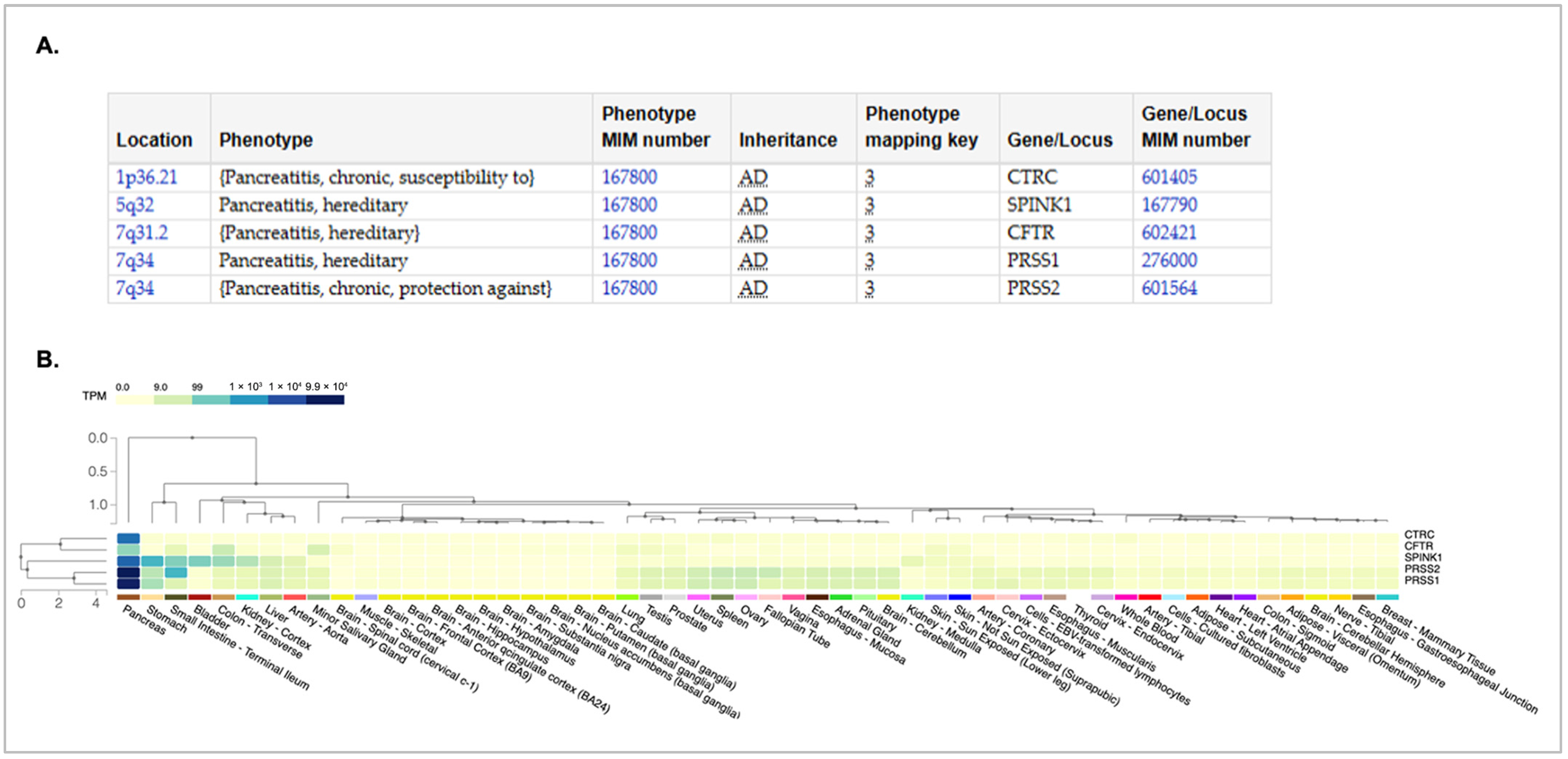
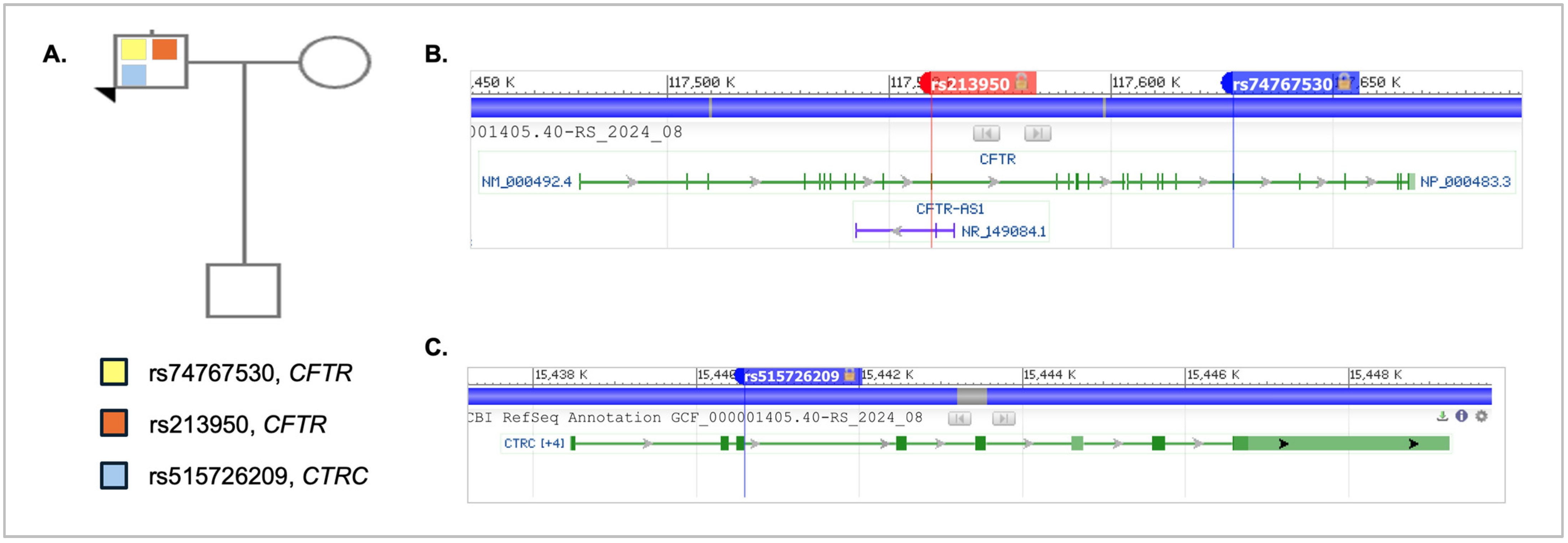
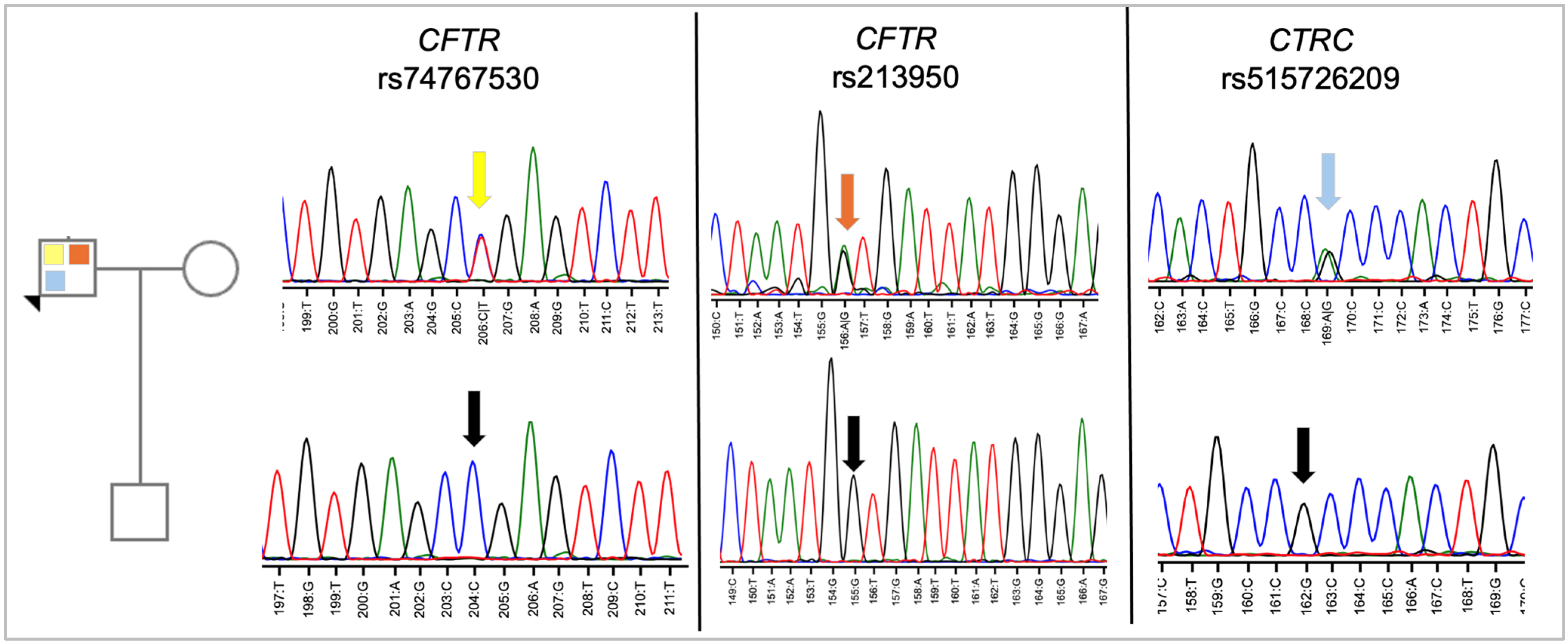
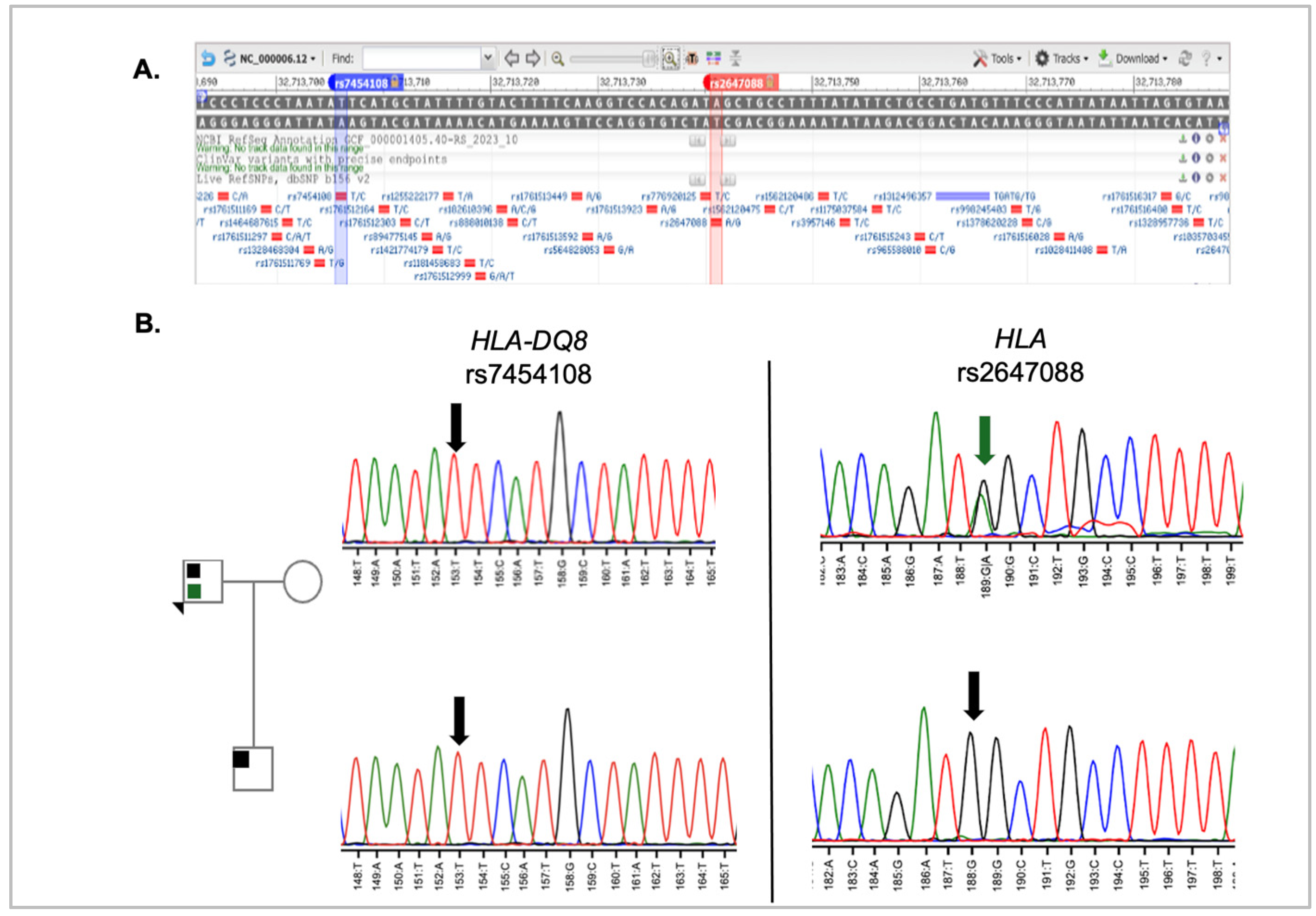
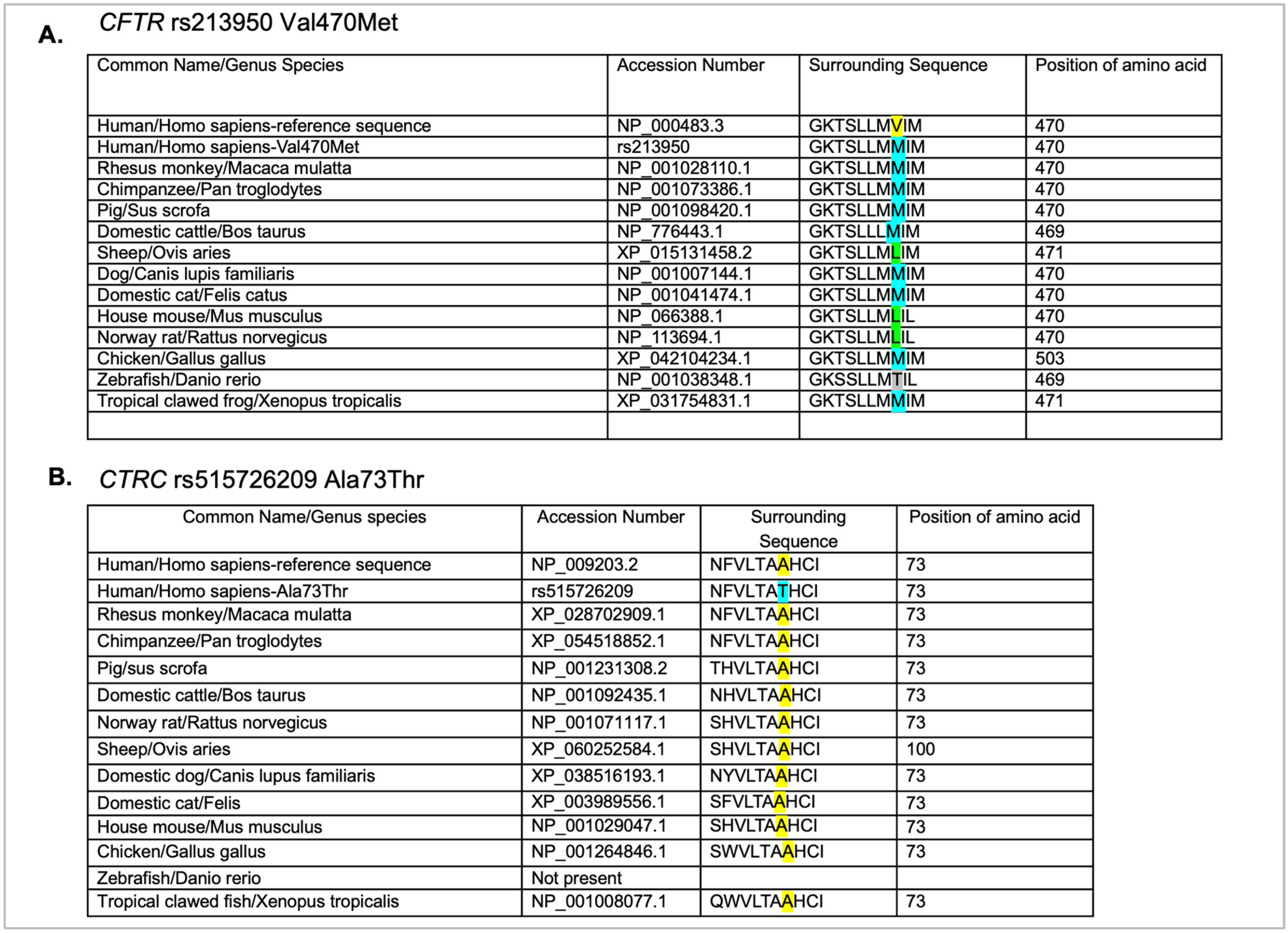


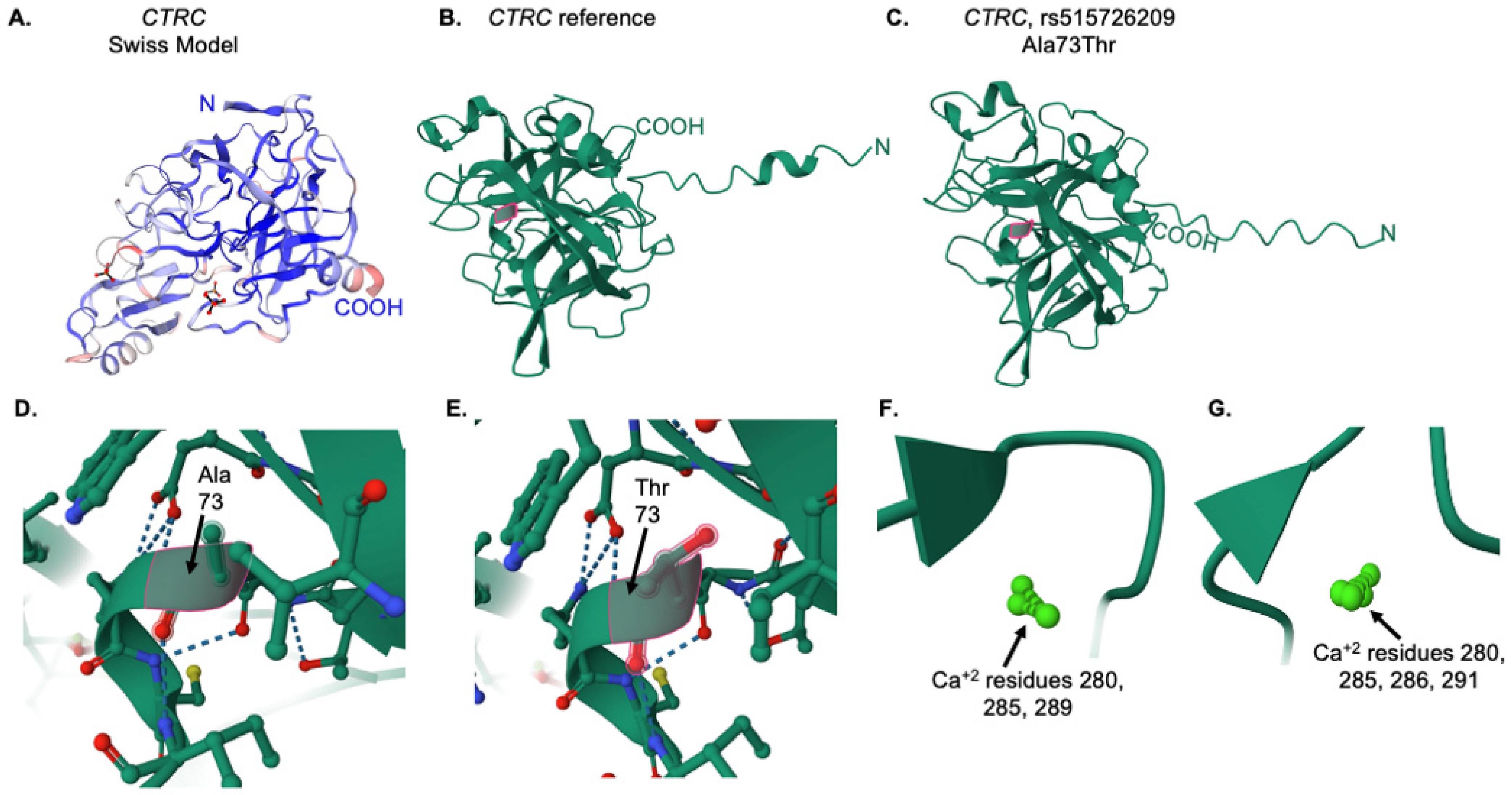
| Gene | DNA Variation | Amino Acid | Variant Type and SNP Number | ClinVar Classification [17] | VarSome Composite Score [18] | Likelihood Ratio Test Algorithm (VarSome) [18] |
|---|---|---|---|---|---|---|
| CFTR | NM_000492.4:c.3484C>T | R [CGA] > * [TGA] Arg1162Ter | Nonsense Variant rs74767530 https://www.ncbi.nlm.nih.gov/snp/rs74767530 (accessed on 20 April 2025) | Pathogenic for cystic fibrosis | Pathogenic/strong | Uncertain |
| CFTR | NM_000492.4:c.2562T>G | T [ACT] > T [ACG] Thr854= | Synonymous Variant rs1042077 https://www.ncbi.nlm.nih.gov/snp/rs1042077 (accessed on 20 April 2025) | Benign/Likely Benign | Benign/strong | N/A |
| CFTR | NM_000492.4:c.1408G>A | V [GTG] > M [ATG] Val470Met | Missense Variant rs213950 https://www.ncbi.nlm.nih.gov/snp/rs213950 (accessed on 20 April 2025) | Benign/Likely Benign | Benign/strong | Pathogenic Supporting |
| PRSS1 | NM_002769.5:c.486T>C | D [GAT] > D [GAC] Asp162= | Synonymous Variant rs6666 https://www.ncbi.nlm.nih.gov/snp/rs6666 (accessed on 20 April 2025) | Benign/Likely Benign | Benign/moderate | N/A |
| PRSS1 | NM_002769.5:c.738T>C | N [AAT] > N [AAC] Asn246= | Synonymous Variant rs6667 https://www.ncbi.nlm.nih.gov/snp/rs6666 (accessed on 20 April 2025) | Benign/Likely Benign | Benign/strong | N/A |
| CTRC | NM_007272.3:c.217G>A | A [GCC] > T [ACC] Ala73Thr | Missense Variant rs515726209 https://www.ncbi.nlm.nih.gov/snp/rs515726209 (accessed on 20 April 2025) | Conflicting classifications of pathogenicityPathogenic (2); Likely pathogenic (1); Uncertain significance (1) for hereditary pancreatitis | Pathogenic/strong | Pathogenic Supporting |
| Gene/Variant | Global Allele Frequency | Asian Allele Frequency |
|---|---|---|
| CFTR rs74767530 | Sample size: 210,486 C = 0.999914 T = 0.000086 | Sample size: 6592 C = 1.0000 T = 0.0000 |
| CFTR rs213950 | Sample size: 361,510 G = 0.577063 A = 0.422937 | Sample size: 6928 G = 0.5592 A = 0.4408 |
| CTRC rs515726209 | Sample size: 30,086 G = 0.99997 T = 0.00000 A = 0.00003 | Sample size: 202 G = 1.000 T = 0.000 A = 0.000 |
| HLA-DQ8 rs7454108 | Sample size: 223,290 T = 0.898303 C = 0.101697 | Sample size: 6598 T = 0.9230 C = 0.0770 |
| HLA rs2647088 | Sample size: 30,272 A = 0.72612 G = 0.27388 | Sample size: 436 A = 0.631 G = 0.369 |
Disclaimer/Publisher’s Note: The statements, opinions and data contained in all publications are solely those of the individual author(s) and contributor(s) and not of MDPI and/or the editor(s). MDPI and/or the editor(s) disclaim responsibility for any injury to people or property resulting from any ideas, methods, instructions or products referred to in the content. |
© 2025 by the authors. Licensee MDPI, Basel, Switzerland. This article is an open access article distributed under the terms and conditions of the Creative Commons Attribution (CC BY) license (https://creativecommons.org/licenses/by/4.0/).
Share and Cite
Sharma, Y.; Good, D.J. Case Study: Genetic and In Silico Analysis of Familial Pancreatitis. Genes 2025, 16, 603. https://doi.org/10.3390/genes16050603
Sharma Y, Good DJ. Case Study: Genetic and In Silico Analysis of Familial Pancreatitis. Genes. 2025; 16(5):603. https://doi.org/10.3390/genes16050603
Chicago/Turabian StyleSharma, Yash, and Deborah J. Good. 2025. "Case Study: Genetic and In Silico Analysis of Familial Pancreatitis" Genes 16, no. 5: 603. https://doi.org/10.3390/genes16050603
APA StyleSharma, Y., & Good, D. J. (2025). Case Study: Genetic and In Silico Analysis of Familial Pancreatitis. Genes, 16(5), 603. https://doi.org/10.3390/genes16050603








